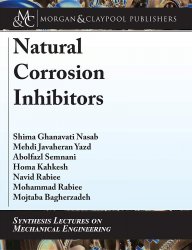 Название: Natural Corrosion Inhibitors
Название: Natural Corrosion Inhibitors Автор: Shima Ghanavati Nasab, Mehdi Javaheran Yazd, Abolfazl Semnani
Издательство: Morgan & Claypool Publishers
Серия: Synthesis Lectures on Mechanical Engineering
Год: 2019
Страниц: 98
Язык: английский
Формат: pdf (true)
Размер: 10.6 MB
Regarding the vast use of chemical components in different human activities, they are susceptible to corrosion because of contact with aggressive environments.
Therefore, the use of inhibitors for the control of corrosion of chemical components in corrosive media is an urgent affair. Numerous investigations were carried out and are still being done to study the corrosion inhibition potential of organic compounds. Remarkable inhibition efficiency was achieved by all these compounds particularly some with N, S, and O atoms in their structure. Unfortunately, most of these compounds are not only expensive but also toxic to living beings. Hence, it is essential to mention the importance of natural inhibitors as eco-friendly, readily available, and renewable sources. The main goal of this book is to point out the influence of these components in terms of physical and, in some cases, chemical, processes on different components in aggressive media. Different methods of measuring corrosion, adsorption behavior, mechanism of inhibitors, and some related information is presented in this book. There is a lack of comprehensive and relevant books on this subject, so we decided to write this book in order to accumulate useful information about the influence of natural inhibitors on metals in corrosive areas and to make it accessible to researchers.
The most extensive used metal is iron. Different methods have been developed to control and prevent corrosion in many environments. Using inhibitors is one of the most pragmatic strategies to prolong corrosion progress which has become widespread recently. Different organic and inorganic barriers have been studied to control corrosion of metals. Most organic compounds include nucleophiles like nitrogen, sulfur, oxygen atoms, heterocyclic compounds, and -electrons which allow an adsorption on metal surface. These compounds can be adsorbed on metal surface and block active surface sites to decrease the corrosion rate. Although many organic compounds such as aliphatic amines, aromatic amines, aromatic aldehyde, aromatic acids, carbonyl compounds, phenol, thiosemicarbazide derivatives, hydrazine derivatives, amino acids, antibacterial drugs, Schiff bases, alkylimidazolium ionic liquids, organic dye, anionic surfactants, cationic surfactants, nonionic surfactants, pyridine derivatives, benzotriazole derivatives, triazoline derivatives, and tetrazole derivatives reveal good anticorrosive action, most of them are expensive, poisonous and enhance environmental concerns. These properties make them undesirable.
Inorganic compounds like chromates, dichromates, and nitrates are also applied to control corrosion rate by acting as anodic inhibitors. Unfortunately, the biological toxicity of these inorganic, especially chromates and organophosphates are pointing toward their environmentally harmful properties. Although, many synthesized compounds manifest good corrosion inhibitor, most of them are highly toxic to both human beings and environment.
These harmful factors lead natural inhibitors to develop. Recently most of attentions are focused on using natural inhibitors, for example plant seeds, leaves, plants aqueous extract, peels, fruits, pectin, lignin, oil extracts, plant alkaloids extracts, and etc. as the most important and favorable compounds for the environment and human. They have some pros over chemical inhibitors including being nonpoisonous, cheap, environmentally friendly, renewable, and readily available which make them helpful.
Скачать Natural Corrosion Inhibitors